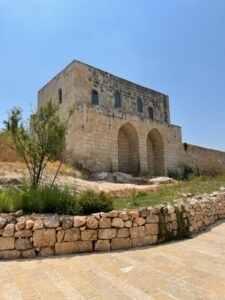
KFAR SABA, Israel — Michal and I had planned an overnight in Jerusalem with friends from New York. With the predictable hot weather (90 degrees and sunny everyday) of the metro Tel Aviv area, a sojourn in Jerusalem is always a summer treat. Jerusalem’s altitude is about 3,000 ft, so the days are usually a bit cooler in summer than in Kfar Saba and the nights are actually cool.
Our friends Hank and Rebecca live most of the year in Manhattan. They have an apartment by the sea in Netanya and usually spend a few months every year in Israel, but like many others, they hadn’t visited in nearly three years due to the pandemic. Hank, a retired history professor, has an unusual story. When he planned to go to college in the mid-1950s, someone told him about Hebrew University in Jerusalem offering scholarships for American students. Hank, who had forgotten all about his scholarship application, was unexpectedly accepted and he set off on a tramp steamer for Israel, knowing no Hebrew and with no Israeli acquaintances.
His first weekend on campus, Hank was surprised that on Friday everyone had disappeared and there was no place open to even buy food. Why? Shabbat starts on Friday at sundown making Friday a quasi day off. But by the second weekend he had made a friend who hosted him for Shabbat. Eventually Hank returned to New York, finished his undergraduate degree and then attended graduate school, supporting himself by boxing professionally. He had a lengthy career as a professor and a dean in New Jersey colleges. Rebecca’s career was in international business and they are both quite busy with the American Jewish Committee, whose main office in Jerusalem was serendipitously located just next to our hotel!

On our numerous trips to Jerusalem, we have always passed through Sha’ar HaGai, also known as Bab el-Wad, on the highway where the Judean Mountains begin. It was a deserted building visible from the highway, with a number of War of Independence armored vehicles arrayed beside it. But recently it has become a national memorial site. The khan there, which was built as a wayside inn during the Ottoman period, is situated in the narrow opening of Wadi Nahshon, on the main road connecting the lowlands with Jerusalem.
This road saw fierce battles during the War of Independence, with Arab villagers on the heights shooting at the Jewish vehicles in the narrow defile below. This effectively prevented food and ammunition from getting to Jerusalem, which was under siege during the war. In memory of the men and women who took part in the convoys to Jerusalem, a heritage center was established in the khan, dedicated to those who broke through to Jerusalem, or died trying.
How did the Jewish fighters open the way to Jerusalem? A narrow mountainous path, just about passable for a Jeep, was discovered on the mountain side. It was suitable as a route to detour trucks from the highway. The mountain path was hastily enlarged as a bypass to provide the Jews of Jerusalem with vital water, food, and other supplies, especially ammunition. It was named after the mountainous Burma Road formed by the Allied forces during World War 2.
We learned all about Sha’ar HaGai at the museum constructed in the renovated khan buildings. There were several films showing various aspects of the battles on and near the site, with interactive “games” in which young and old visitors can participate. We were presented with realistic scenarios requiring life or death decisions. I didn’t always make the right decision. The examples of the soldiers’ tenacity in the face of huge odds were inspiring. The filmed interviews of fighters who were participants in the battles there were very emotive eye witness accounts.
A visit to the museum must be reserved in advance, similar to many of Israel’s new, smaller museums. Afterwards we had a chance to sit in some of the reconstructed vehicles and, of course, visit the gift shop. We were very pleased to be educated about this crucial site and we recommend it highly. https://en.parks.org.il/reserve-park/gay/
That afternoon we checked into our centrally located boutique hotel (the Bezalel) near City Tower and the Italian Synagogue, leaving the car at a nearby parking garage. Hank had arranged a private tour of Mea Sha’arim, the most famous neighborhood of Jerusalem’s ultra-Orthodox population, aka Haredim. Our guide Akiva is the son of Hank’s Bible study partner in the US. Akiva studies at a kollel in Mea Sha’arim where married men learn Torah and receive a government stipend. He and his family live in another neighborhood of Jerusalem. His wife is the head nurse in charge of births at the famous Bikur Cholim Hospital, the oldest in Israel. Akiva also works, at night.
Touring Mea Sha’arim is like walking into a time warp. There, history is embodied in the people and their way of life. The neighborhood was built in 1874 by a group of shareholders who pooled their resources to purchase the tract of land, Mea Sha’arim was the second Jewish neighborhood to be built outside the walls of the Old City.
At that time, living outside the walls was a perilous enterprise, but the walled city had become just too crowded. Mea Sha’arim has preserved its independent character and many (but not all) residents have very little contact with the rest of the city. This world unto itself is defined by both Hasidic and non-Hasidic, ultra-Orthodox Judaism in its most stringent form. Men wear long black coats or black suits, regardless of the weather. On their heads, they wear black hats or shtreimels, black fur hats that are a mark of prestige in the Hasidic communities. Women and even little girls wear thick stockings in all weather, and all females are dressed with extreme modesty. Skirts must be neither too long nor too short – the first being too reminiscent of trendy Jerusalemite garb, the second being too provocative. https://www.gojerusalem.com/items/268/Meah-Shearim/
We saw clotheslines full of white shirts and others full of black garments. Although most of the buildings are run down, prices are still quite high. There are many large synagogues, often in buildings built exclusively for the many different sects living there. (You can identify the sects’ adherents by their distinct, old-fashioned costumes.) But you also see men just wearing black pants and white shirts and laborers who are not members of the community. There are many small shops supplying the needs of the community.
It’s customary for families to have 10 or even 12 children. The older children often care for the younger ones – even if they are not that old themselves. It’s not uncommon to see a ten year-old girl pushing a baby carriage down the street, with another child holding onto the carriage beside her. You see plenty of youngsters playing in the narrow streets or the many courtyards. We also saw families coming from weddings and other events with the children dressed in matching outfits.
The apartment buildings are several stories tall. We saw more than one mother lugging a baby carriage up the steep steps. Akiva ran into an acquaintance of his, Rav Hershler, who immediately invited us up to his cramped apartment. We marveled at the many mattresses piled up for Shabbat guests, up to 10 in a room! While he lives in meager circumstances, the Rav spends much of his time collecting money for those in need of help. Of course, we made some donations ourselves before leaving his 3rd floor walk-up. The visit was a fascinating experience.
That night we had an excellent dinner in The Veranda Restaurant overlooking the Old City, located in the posh David Citadel Hotel. We walked back to our conveniently located boutique hotel through the busy neighborhood in the city center. On the way, we passed through the crowded courtyard of the Hebrew Music Museum, where a band was playing American country songs. This relatively new museum was built at great expense by a French Jew. There are four restaurants surrounding the courtyard, guaranteeing a large crowd in good weather. It was an excellent finish to our wonderful day.